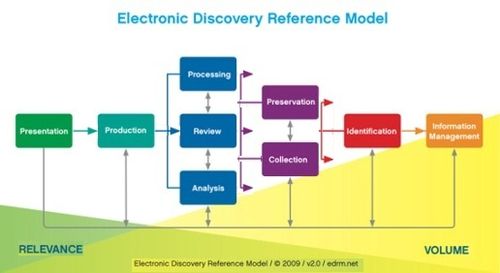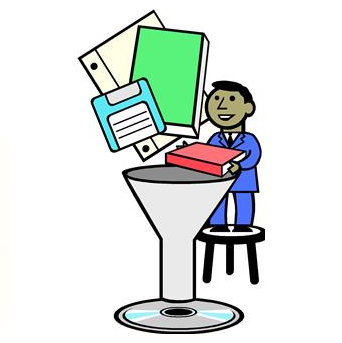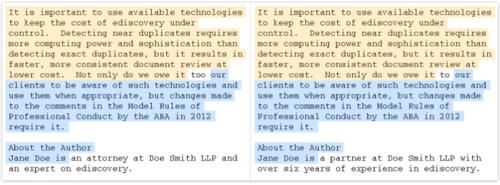The Number of Pages in Each Gigabyte Can Vary Widely – eDiscovery Replay

Even those of us at eDiscovery Daily have to take an occasional vacation (see above); however, instead of “going dark” for the week, we thought we would use the week to do something interesting. Up to this week, we have had 815 posts over 3+ years of the blog. Some have been quite popular, so we thought we would “replay” the top four all-time posts this week in terms of page views since the blog began (in case you missed them). Casey Kasem would be proud! With nearly 1,000 lifetime views, here is the fourth most viewed post all time, originally published in July 2012. Enjoy!
_________________________
A while back, we talked about how the average number of pages in each gigabyte is approximately 50,000 to 75,000 pages and that each gigabyte effectively culled out can save $18,750 in review costs. But, did you know just how widely the number of pages per gigabyte can vary?
The “how many pages” question comes up a lot and I’ve seen a variety of answers. Michael Recker of Applied Discovery posted an article to their blog last week titled Just How Big Is a Gigabyte?, which provides some perspective based on the types of files contained within the gigabyte, as follows:
“For example, e-mail files typically average 100,099 pages per gigabyte, while Microsoft Word files typically average 64,782 pages per gigabyte. Text files, on average, consist of a whopping 677,963 pages per gigabyte. At the opposite end of the spectrum, the average gigabyte of images contains 15,477 pages; the average gigabyte of PowerPoint slides typically includes 17,552 pages.”
Of course, each GB of data is rarely just one type of file. Many emails include attachments, which can be in any of a number of different file formats. Collections of files from hard drives may include Word, Excel, PowerPoint, Adobe PDF and other file formats. So, estimating page counts with any degree of precision is somewhat difficult.
In fact, the same exact content ported into different applications can be a different size in each file, due to the overhead required by each application. To illustrate this, I decided to conduct a little (admittedly unscientific) study using yesterday’s one page blog post about the Apple/Samsung litigation. I decided to put the content from that page into several different file formats to illustrate how much the size can vary, even when the content is essentially the same. Here are the results:
- Text File Format (TXT): Created by performing a “Save As” on the web page for the blog post to text – 10 KB;
- HyperText Markup Language (HTML): Created by performing a “Save As” on the web page for the blog post to HTML – 36 KB, over 3.5 times larger than the text file;
- Microsoft Excel 2010 Format (XLSX): Created by copying the contents of the blog post and pasting it into a blank Excel workbook – 128 KB, nearly 13 times larger than the text file;
- Microsoft Word 2010 Format (DOCX): Created by copying the contents of the blog post and pasting it into a blank Word document – 162 KB, over 16 times larger than the text file;
- Adobe PDF Format (PDF): Created by printing the blog post to PDF file using the CutePDF printer driver – 211 KB, over 21 times larger than the text file;
- Microsoft Outlook 2010 Message Format (MSG): Created by copying the contents of the blog post and pasting it into a blank Outlook message, then sending that message to myself, then saving the message out to my hard drive – 221 KB, over 22 times larger than the text file.
The Outlook example was probably the least representative of a typical email – most emails don’t have several embedded graphics in them (with the exception of signature logos) – and most are typically much shorter than yesterday’s blog post (which also included the side text on the page as I copied that too). Still, the example hopefully illustrates that a “page”, even with the same exact content, will be different sizes in different applications. As a result, to estimate the number of pages in a collection with any degree of accuracy, it’s not only important to understand the size of the data collection, but also the makeup of the collection as well.
So, what do you think? Was this example useful or highly flawed? Or both? Please share any comments you might have or if you’d like to know more about a particular topic.
Disclaimer: The views represented herein are exclusively the views of the author, and do not necessarily represent the views held by CloudNine Discovery. eDiscoveryDaily is made available by CloudNine Discovery solely for educational purposes to provide general information about general eDiscovery principles and not to provide specific legal advice applicable to any particular circumstance. eDiscoveryDaily should not be used as a substitute for competent legal advice from a lawyer you have retained and who has agreed to represent you.









